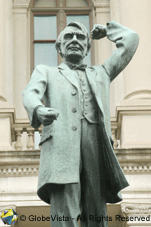Thomas Edward Watson statue

Public Art: Thomas Edward Watson statue
Sculptor: © Joseph S Klein
Date: The statue was erected in the early 1920s, but was dedicated on the 4th December 1932.
Description: A 12 ft tall bronze statue of Thomas E Watson. Watson is depicted dressed in a bow tie and long coat, with his right leg forward and his left hand raised in a fist. His right arm is lower but his hand is also making a fist. The statue encapsulates the aggressive manner to which Watson was known.
Location: In the center of the plaza leading to the main entrance of the Georgia Capitol building, Atlanta, United States.
Inscription :
Thomas E Watson
Born Sept 5th 1856
Died Sept 26th 1922
Honor’s path he trod
Editor, lawyer, historian,
author, orator, statesman.
Author of
Rural free delivery
a champion of the right who
never faltered in the cause
Who was Thomas E Watson ?: Thomas Edward Watson (September 5, 1856 – September 26, 1922), was generally known as Tom Watson. Watson was a US politician from Georgia who kind of blew any chance of a great political career, due, in part, to his fiery attacks on the Roman Catholic Church, African Americans, Jews, the League of Nations, President Woodrow Wilson and the war effort in World War I ( did I mention he also called for the reorganization of the Ku Klux Klan).
In his early years, ironically he was a great supporter of poor farmers and the working class and was instrumental in the founding of the Georgia Populist Party. One of the party’s main goals was to overcome racial divides and push for the right of African American men to vote. However, somewhere along the line it all comes undone, Watson, became a racist and an anti- Semite, blaming the minorities in the South for the failure of Populism. With failed presidential candidacies under his belt, he focused on his publications, Watson’s Magazine and The Jeffersonian, where he was able to voice his views.
Leo Frank Controversy: Thomas E Watson was probably best (or sadly) remembered for his involvement in the case of Leo Frank. In 1915, poor Leo, a Jewish pencil factory manager, was accused of murdering and raping fellow worker, 13-year-old Mary Phagan.
Watson, using his newspaper (The Jeffersonian), began a press campaign to sensationalize the case and bully the jury into convicting Frank. “Satyr-faced New York Jew” and a “rich, depraved Sodomite Jew.” were just some of the words he used to describe him. Despite other newspapers, such as The Hearst, taking Leo’s side, Watson’s influence seemed to have worked, in part. Leo was found guilty and sentenced to death, but new evidence was discovered shortly after, which cast considerable doubt over his guilt. In light of the new evidence, Governor John Slaton commuted Leo’s death sentence to life imprisonment.
Watson was furious with the decision and urged the lynching of not only Leo but the Governor too. A group of about 26 prominent Georgian lawyers, judges and even an ex-Governor formed the Knights of Mary Phagan. On the 17th August, the Knights of Mary Phagan entered the Milledge-ville prison in the middle of the night and kidnapped Leo. He was taken to Frey’s Gin, near Marietta, and hung from a tree. Prior to his lynching, the mob allowed him to write a note to his wife. His last words were believed to be ‘I think more of my wife and my mother than I do of my own life.’ No one was ever prosecuted for this crime.
Whilst the lynching led to the founding of the Anti-Defamation League, members of the lynching mob responded somewhat differently by establishing a new Klu Klux Klan.
In 1982, over 65 years later, Alonzo Mann, an ex pencil factory employee signed an affidavit stating he saw Conley, a janitor (not Leo), carrying Mary’s body into the basement on the day in question As a result of some hard fighting by the Anti-Defamation League, on March 11th, 1986, Leo Franks was finally issued a pardon by the Georgia pardons and paroles board (however they refused to clear him of the crime).
So why is Thomas E Watson’s statue outside the Georgia State Capitol building again?
History of the Thomas Watson statue: On the 21st of August, 1925, the General Assembly passed a resolution authorizing placement of a statue of Watson on Capitol property.
In 1941 students protested on the statue.
Over the years numerous groups have tried to have the statue removed from the Georgia State Capitol.